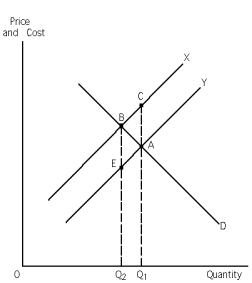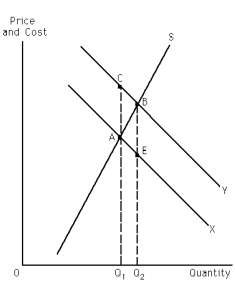A) $350
B) $250
C) $300
D) $140
E) $540
Correct Answer

verified
Correct Answer
verified
Multiple Choice
A nonexcludable public good is
A) nonrivalrous in consumption.
B) rivalrous in consumption.
C) asymmetric.
D) a good for which it is impossible (or prohibitively costly) to exclude someone from receiving the benefits of its services.
E) a and d
Correct Answer

verified
Correct Answer
verified
Multiple Choice
A negative externality is internalized when __________ until the socially optimum level of production is obtained.
A) supply shifts to the left
B) supply shifts to the right
C) demand shifts to the right
D) b and c
E) none of the above
Correct Answer

verified
Correct Answer
verified
Multiple Choice
Insurance deductibles __________ the __________ problem of insurance coverage.
A) are meant to reduce; adverse selection
B) are meant to reduce; moral hazard
C) unintentionally worsen; adverse selection
D) unintentionally worsen; moral hazard
Correct Answer

verified
Correct Answer
verified
Multiple Choice
Exhibit 31-3
 -Refer to Exhibit 31-3.Suppose that Firms A,B,and C are the only polluters in the state and that each emits 4 tons of pollution into the atmosphere.To cut the level of pollution in half,the government mandates system whereby each firm must reduce its pollution level by one-half.The total cost of complying with the mandate is
-Refer to Exhibit 31-3.Suppose that Firms A,B,and C are the only polluters in the state and that each emits 4 tons of pollution into the atmosphere.To cut the level of pollution in half,the government mandates system whereby each firm must reduce its pollution level by one-half.The total cost of complying with the mandate is
A) $433.
B) $1,540.
C) $2,750.
D) $8,570.
E) $11,650.
Correct Answer

verified
Correct Answer
verified
Multiple Choice
The free-rider problem arises if goods are
A) nonrivalrous in consumption.
B) rivalrous in consumption.
C) nonexcludable.
D) excludable.
E) a and d
Correct Answer

verified
Correct Answer
verified
Multiple Choice
Exhibit 31-1
 -Refer to Exhibit 31-1.If the exhibit represents a negative externality situation,the triangle ABC is representative of
-Refer to Exhibit 31-1.If the exhibit represents a negative externality situation,the triangle ABC is representative of
A) social failure.
B) optimal failure.
C) market failure.
D) socially optimal output.
E) none of the above
Correct Answer

verified
Correct Answer
verified
True/False
When a negative externality exists,the market is said to underproduce the good connected with the negative externality.
Correct Answer

verified
Correct Answer
verified
Multiple Choice
A positive externality exists when
A) a person's or group's actions cause a benefit that is felt by others.
B) a person's or group's actions cause a cost that is felt by others.
C) market output is less than socially optimal output.
D) a and c
E) b and c
Correct Answer

verified
Correct Answer
verified
Multiple Choice
Generally,positive externalities result in
A) too much of a good being produced.
B) the socially optimal output of a good being produced.
C) too little of a good being produced.
D) either a or c
E) any of the above
Correct Answer

verified
Correct Answer
verified
Multiple Choice
One consequence of a negative externality is that
A) social costs are greater than private costs.
B) private costs are greater than social costs.
C) the marginal private cost curve slopes upward.
D) the market output is less than the socially optimal output.
E) a and c
Correct Answer

verified
Correct Answer
verified
Multiple Choice
A positive externality is internalized when
A) demand shifts to the right until the socially optimum level of output is obtained.
B) demand shifts to the left until the socially optimum level of production is obtained.
C) supply shifts to the left until the socially optimum level of production is obtained.
D) b and c
E) none of the above
Correct Answer

verified
Correct Answer
verified
Multiple Choice
A nonexcludable public good is characterized by nonrivalry in
A) production and nonexcludability.
B) consumption and rivalry in production.
C) consumption and excludability.
D) consumption and nonexcludability.
E) none of the above
Correct Answer

verified
Correct Answer
verified
Multiple Choice
Exhibit 31-3
 -Refer to Exhibit 31-3.Suppose that Firms A,B,and C are the only polluters in the state and that each emits 4 tons of pollution into the atmosphere.To cut the level of pollution in half the government issues two transferable pollution permits to each firm. What is the total cost to society of decreasing pollution to half its present level if firm C buys one pollution permit from firm A and one pollution permit from firm B?
-Refer to Exhibit 31-3.Suppose that Firms A,B,and C are the only polluters in the state and that each emits 4 tons of pollution into the atmosphere.To cut the level of pollution in half the government issues two transferable pollution permits to each firm. What is the total cost to society of decreasing pollution to half its present level if firm C buys one pollution permit from firm A and one pollution permit from firm B?
A) $515
B) $1,300
C) $1,380
D) $965
E) $10,350
Correct Answer

verified
Correct Answer
verified
Multiple Choice
If the consumption of a good by one person reduces the amount of it that can be consumed by others,the good is
A) excludable.
B) nonexcludable.
C) rivalrous in consumption.
D) nonrivalrous in consumption.
Correct Answer

verified
Correct Answer
verified
Multiple Choice
If private property rights were established in the air,there would probably be
A) more air pollution.
B) less air pollution.
C) the same amount of air pollution that exists without private property rights in the air.
D) better weather.
Correct Answer

verified
Correct Answer
verified
Multiple Choice
There are two divorce laws,A and B.Under A,it takes only one person to agree to a divorce and the divorce is granted.Under B,it takes two persons to agree to a divorce before it is granted.According to Coase,
A) there will be the same number of divorces under both laws if transaction costs are zero.
B) there will be more divorces under law A.
C) there will be more divorces under law B.
D) taxes should be imposed on those parties who seek divorces.
E) subsidies should be granted to those persons who unwillingly get divorces.
Correct Answer

verified
Correct Answer
verified
Multiple Choice
In the case of a positive externality,the entire demand curve lies
A) above the entire marginal social benefit curve.
B) below the entire marginal social benefit curve.
C) above the entire supply curve.
D) below the entire supply curve.
E) b and c
Correct Answer

verified
Correct Answer
verified
Multiple Choice
Exhibit 31-2
 -Refer to Exhibit 31-2.If Exhibit 30-2 exhibits a positive externality situation,then what is Q2?
-Refer to Exhibit 31-2.If Exhibit 30-2 exhibits a positive externality situation,then what is Q2?
A) It is the quantity of output at which marginal social benefits (MSB) equal marginal private benefits (MPB) .
B) It is the quantity of output at which MPB > MSB.
C) It is the market output-the quantity of output that exists if the external benefits associated with the positive externality are not taken into account.
D) It is the socially optimal output-the quantity of output that exists if the external benefits associated with the positive externality are taken into account.
E) none of the above
Correct Answer

verified
Correct Answer
verified
Multiple Choice
Suppose the production of a good results in negative externalities.If output is at the intersection of the demand curve and the marginal social cost curve,then
A) the socially optimal level of output will be produced.
B) society will incur a net social cost.
C) society will want less output produced, and producers will be willing to satisfy this desire at a price that society deems acceptable.
D) b and c
Correct Answer

verified
Correct Answer
verified
Showing 41 - 60 of 185
Related Exams